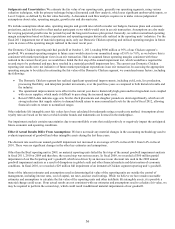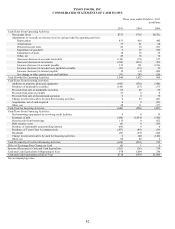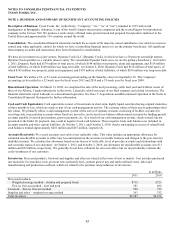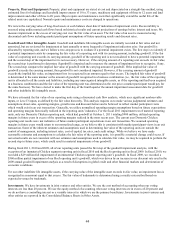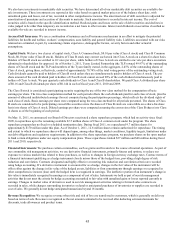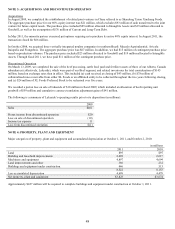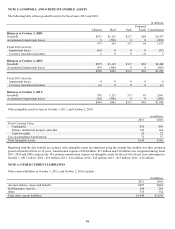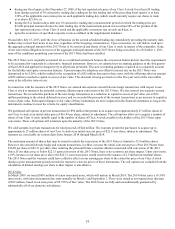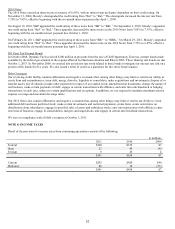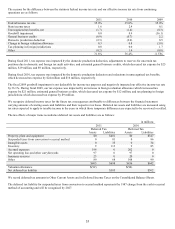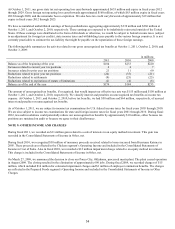Tyson Foods 2011 Annual Report Download - page 44
Download and view the complete annual report
Please find page 44 of the 2011 Tyson Foods annual report below. You can navigate through the pages in the report by either clicking on the pages listed below, or by using the keyword search tool below to find specific information within the annual report.44
Property, Plant and Equipment: Property, plant and equipment are stated at cost and depreciated on a straight-line method, using
estimated lives for buildings and leasehold improvements of 10 to 33 years, machinery and equipment of three to 12 years and land
improvements and other of three to 20 years. Major repairs and maintenance costs that significantly extend the useful life of the
related assets are capitalized. Normal repairs and maintenance costs are charged to operations.
We review the carrying value of long-lived assets at each balance sheet date if indication of impairment exists. Recoverability is
assessed using undiscounted cash flows based on historical results and current projections of earnings before interest and taxes. We
measure impairment as the excess of carrying cost over the fair value of an asset. The fair value of an asset is measured using
discounted cash flows including market participant assumptions of future operating results and discount rates.
Goodwill and Other Intangible Assets: Goodwill and indefinite life intangible assets are initially recorded at fair value and not
amortized, but are reviewed for impairment at least annually or more frequently if impairment indicators arise. Our goodwill is
allocated by reporting unit, and we follow a two-step process to evaluate if a potential impairment exists. The first step is to identify if
a potential impairment exists by comparing the fair value of a reporting unit with its carrying amount, including goodwill. If the fair
value of a reporting unit exceeds its carrying amount, goodwill of the reporting unit is not considered to have a potential impairment
and the second step of the impairment test is not necessary. However, if the carrying amount of a reporting unit exceeds its fair value,
the second step is performed to determine if goodwill is impaired and to measure the amount of impairment loss to recognize, if any.
The second step compares the implied fair value of goodwill with the carrying amount of goodwill. If the implied fair value of
goodwill exceeds the carrying amount, then goodwill is not considered impaired. However, if the carrying amount of goodwill
exceeds the implied fair value, an impairment loss is recognized in an amount equal to that excess. The implied fair value of goodwill
is determined in the same manner as the amount of goodwill recognized in a business combination (i.e., the fair value of the reporting
unit is allocated to all the assets and liabilities, including any unrecognized intangible assets, as if the reporting unit had been acquired
in a business combination and the fair value of the reporting unit was determined as the exit price a market participant would pay for
the same business). We have elected to make the first day of the fourth quarter the annual impairment assessment date for goodwill
and other indefinite life intangible assets.
We have estimated the fair value of our reporting units using a discounted cash flow analysis, which uses significant unobservable
inputs, or Level 3 inputs, as defined by the fair value hierarchy. This analysis requires us to make various judgmental estimates and
assumptions about sales, operating margins, growth rates and discount factors and is believed to reflect market participant views
which would exist in an exit transaction. Generally, we utilize normalized operating margin assumptions based on future expectations
and operating margins historically realized in the reporting units’ industries. For the fiscal 2011 impairment test of material reporting
units, only our Domestic Chicken reporting unit, which had goodwill at October 1, 2011 totaling $900 million, utilized operating
margins in future years in excess of the operating margins realized in the most recent year. The current year Domestic Chicken
reporting unit results were not indicative of future market participant expectations in an exit transaction. We assumed operating
margins in future years would return to our normalized range, as we believe this is consistent with market participant views in an exit
transaction. Some of the inherent estimates and assumptions used in determining fair value of the reporting units are outside the
control of management, including interest rates, cost of capital, tax rates, and credit ratings. While we believe we have made
reasonable estimates and assumptions to calculate the fair value of the reporting units, it is possible a material change could occur. If
our actual results are not consistent with our estimates and assumptions used to calculate fair value, we may be required to perform the
second step in future years, which could result in material impairments of our goodwill.
During fiscal 2011, 2010 and 2009, all of our reporting units passed the first step of the goodwill impairment analysis, with the
exception of an immaterial Chicken segment reporting unit in fiscal 2010 and the Beef reporting unit in fiscal 2009. In fiscal 2010, we
recorded a $29 million full impairment of an immaterial Chicken segment reporting unit’s goodwill. In fiscal 2009, we recorded a
$560 million partial impairment of our Beef reporting unit’s goodwill, which was driven by an increase in our discount rate used in the
2009 annual goodwill impairment analysis as a result of disruptions in global credit and other financial markets and deterioration of
economic conditions.
For our other indefinite life intangible assets, if the carrying value of the intangible asset exceeds its fair value, an impairment loss is
recognized in an amount equal to that excess. The fair value of trademarks is determined using a royalty rate method based on
expected revenues by trademark.
Investments: We have investments in joint ventures and other entities. We use the cost method of accounting when our voting
interests are less than 20 percent. We use the equity method of accounting when our voting interests are in excess of 20 percent and
we do not have a controlling interest or a variable interest in which we are the primary beneficiary. Investments in joint ventures and
other entities are reported in the Consolidated Balance Sheets in Other Assets.




